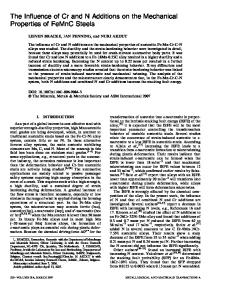Intercritical Austenitization of Two Fe-Mn-C Steels
- PDF / 2,415,923 Bytes
- 5 Pages / 594 x 774 pts Page_size
- 53 Downloads / 303 Views
I.
INTRODUCTION
W I T H the introduction of dual-phase steels ~ intercritical austenitization became of technological interest. The current understanding about this reaction :-5 is that it is a complex, sequential process, particularly in the case of initial microstructures composed of pearlite and f e r r i t e . 3'4'5 Speich et al 5 delineated the process of intercritical austenitization in such steels into three distinct stages, v i z . , (i) a rapid growth of austenite into pearlite until complete pearlite dissolution, (ii) a slow growth of austenite into ferrite, and (iii) slow equilibration of ferrite and austenite. The growth of austenite into ferrite is diffusion controlled and either carbon 4 or substitutional (Mn) partitioning 5 between ferrite and austenite has been proposed to be the critical step in the reaction. The nucleation of austenite seems to occur rather easily at carbide particles of ferrite/ferrite boundaries 2'4 and in the pearlite colonies. 4"5 However, very little quantitative information is available about the microstructure evolution of steels subjected to intercritical annealing. In the present work, quantitative microscopy was used to describe the morphology of the microstructures developed in the course of intercritical annealing at 740 ~ in two C-Mn steels, one of them microalloyed with niobium.
II.
EXPERIMENTAL METHODS
The compositions of steels studied are presented in Table I. They were received in the form of 2.5 mm plates with a pearlite-ferrite microstructure produced by controlledrolling. In order to obtain standard homogeneous microstructures in both alloys, they were normalized at 860 ~ for one hour. The resultant microstructures are shown in Figure 1. The microstructural parameters characteristic of the steels i_n this c_hosen standard state are listed in Table II. Here, d~ and dp are the ferritic grain size and the pearlitic M . M . SOUZA is with Eng. e. Ci6ncia dos Materiais Instituto Militar de Engenharia. Pra~a General Tibfircio, Urca. 22290 - Rio de Janeiro. RJ, Brasil. J . R . C . GUIMAR,~ES is with Companhia Brasileira de Metalurgia e Mineraqio, Rua Pe. Joio Manuel 923, 01411 Silo Paulo, S. P., Brasil. K . K . CHAWLA is with Eng. e Ci6ncia dos Materiais Instituto Militar de Engenharia, Praqa General Tibtircio, Urca, 22290 - Rio de Janeiro, RJ, Brasil. Manuscript submitted July 31, 1981. METALLURGICAL TRANSACTIONS A
9
colony size, both determined from mean free-distances.6 SU and S? -p are the area of ferrite-ferrite and that of ferritepearlite interfaces per unit volume of material. Vvp and Vv~ are the volume fractions of pearlite and ferrite, respectively. All heat treatments were performed in a salt bath (60 pct BaC12-20 pct NaC1-20 pct KC1), the temperature of which was controlled within ---2 ~ Intercritical annealings were carried out at 740 ~ for times ranging from 30 seconds to five hours. On water quenching the intercritically annealed specimens. martensite formed in the austenite grains available at the annealing temperature. The amount of martensite o
Data Loading...











